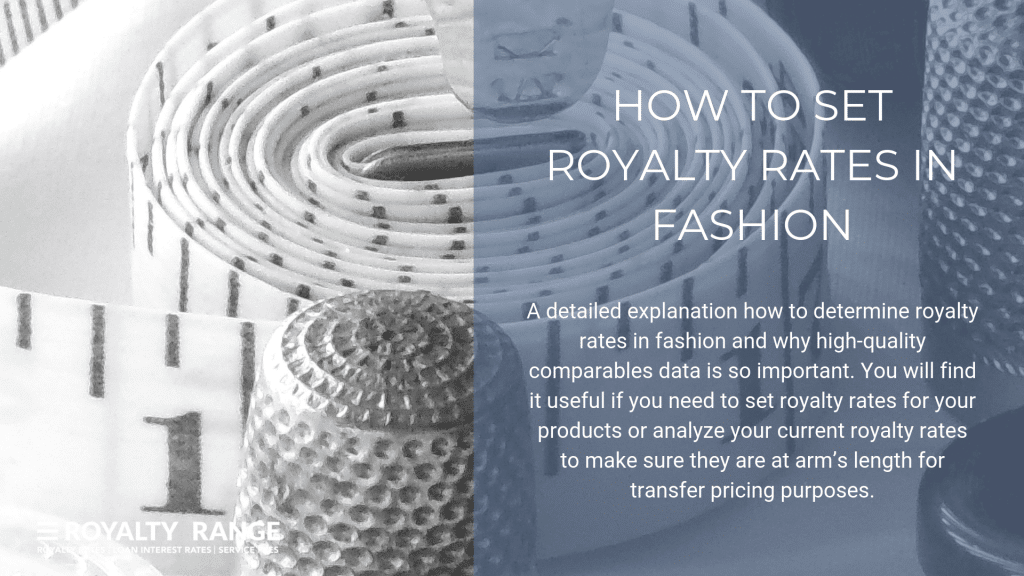How to set royalty rates in fashion

Kris (Kestutis) Rudzika |
April 14, 2019

When you license your fashion-related intellectual property, you will need to negotiate royalty rates with the licensee. In case of intragroup transaction, you would need to rely on third party comparables for transfer pricing compliance purposes. Finding current market data on comparable license agreements will help you set fair royalty rates and strengthen your negotiating or transfer pricing position. You can find comparable royalty rates by using the RoyaltyRange database. If you are ready to start your search, go to the bottom of this page. There, you can quickly and easily order benchmarking studies or royalty rates reports for your industry.
On this page, we explain how to determine royalty rates in fashion and why high-quality comparables data is so important. You will find it useful if you need to set royalty rates for your products or analyze your current royalty rates to make sure they are at arm’s length for transfer pricing purposes.
Licensing intellectual property in the fashion industry
When thinking about royalty rates by industry, the general concept is the same across all industries. A royalty rate is a payment made by a licensee to a licensor to use your intellectual property. You might grant a licensee the right to manufacture handbags featuring a pattern or a weather-resistant fabric you designed. In exchange, you get a royalty payment on the sales revenue generated by the bags. You continue to own the intellectual property rights but you both benefit financially from the profits.
The intellectual property types that are most commonly licensed are trademarks, patents and copyrights. You can also license your design, brand, know-how, trade secrets and more.
Trademarks
Trademarks are commonly licensed in the fashion industry. For example, say you own a clothing brand. You might license your trademark to a jewelry brand for use in a jewelry collection. As your brand only designs and manufactures clothing, you may not have the specialist manufacturing capabilities required to create jewelry. As such, you license the trademark to the jewelry brand to design and manufacture the collection on your behalf. You set a royalty rate so that you get a portion of the revenue from the sales of the jewelry.
You can trademark your name (e.g. ‘AirWair’ by Dr. Martens), logo (e.g. the Nike Swoosh or the Louis Vuitton ‘LV’ monogram) or slogan (e.g. Nike’s ‘Just Do It’). Some luxury fashion brands even have trademarks on colors. For example, Tiffany’s ‘robin’s egg blue’ is a trademark, as are the distinctive red soles on Christian Louboutin shoes.
Patents
Patents can be granted to protect innovative processes in manufacturing. For example, fabric manufacturer Stretchline has a patent for its method of manufacturing tubular fabric for use in bras. Design patents can also be granted. For example, Louis Vuitton has six patents, including for the ‘LockMe’, ‘Twist’ and ‘Petite Malle’ handbags; Balenciaga has two, including for the ‘Bow Bracelet’; Yves Saint Laurent has eight; and Bottega Veneta has three.
Licensing your patent enables you to continue innovating while your licensee uses, develops and markets your patented invention. As the licensee pays royalty rates for the revenue generated by your invention, licensing your patent is financially beneficial for both of you. Say your company has invented innovative breathable insoles for sports shoes, and you have been granted a patent. You can license the patent to a specialist sports shoe manufacturer. By doing so, you can earn royalties and work on new technologies while the licensee uses your invention to develop and market a range of cutting-edge sports shoes.
Copyright
In fashion, copyright generally relates to the creative art elements of designs, such as print patterns. For example, sports equipment company Varsity Brands wanted to protect the design of its cheerleading uniforms. The US Supreme Court ruled that the basic decorative elements could be protected, but the cut and shape could not.
You can license your copyright so that your art design can be used on items your company does not create. For example, a company like Liberty London might license its floral print patterns to a luxury furniture retailer. Liberty does not have the capabilities to create furniture, so this is a way of extending its reach and generating more revenue, while protecting its intellectual property.

Finding recent royalty rates in fashion
The fashion royalty rates you set depend on the type of intellectual property you’re licensing and the sector you work within. You can use the RoyaltyRange database to find comparable royalty rates that you can use as guidelines. As your license agreement is specific to your transaction, you need to make sure the license agreements you find are sufficiently comparable. You can search the RoyaltyRange database by intellectual property type, keyword, date and more to make sure you find the most relevant comparables data. Our experts will also analyze the search results for comparability for transfer pricing purposes.
Whether you need comparable royalty rates in trademark licensing for women’s clothing, accessories and shoes, or brand licensing for men’s ceremonial suits, we can help.
Setting fashion royalty rates: choosing a royalty structure
Royalty rates in fashion are usually set as percentages of the revenue generated by your intellectual property. This can be gross or net revenue. A royalty percentage allows both parties to receive a fair share based on the current value generation and profitability of the intellectual property.
Royalty rates can also be set as fixed fees. You might prefer this if you want to receive the same amount for the use of your intellectual property, regardless of sales or profits.
Calculating a fair royalty percentage
You have a few options when it comes to working out an appropriate royalty percentage. The two main approaches are market-based methods or income-based methods. For both of these approaches, you will need to have access to recent, reliable comparables data. This ensures that the rates you set are reasonable and at arm’s length for transfer pricing purposes (reflect market rates).
Market approach
A market approach (or transactional approach) sets royalty rates by referring to comparable license agreements. You essentially base your fashion royalty rates on those earnt in comparable transactions with comparable intellectual property in comparable markets.
The comparable uncontrolled transaction (CUT) method is one market-based method you can use. It is similar to the comparable uncontrolled price (CUP) method of transfer pricing.
The quickest and most reliable way to find comparable royalty rates in fashion is to search the RoyaltyRange royalty rates database. This lets you find up-to-date, relevant agreements that you can download, analyze and use to set fair, arm’s length fashion royalty rates.
Income approach
The income approach involves calculating an appropriate royalty rate based on the income you expect your intellectual property to generate. The first step is to work out its earning potential. If your licensed intellectual property is to be sold on its own, this is fairly straightforward. If it is to be used in combination with other intellectual property, then you will need to calculate the proportion of the revenue that can be attributed to it.
Two examples of the income approach are the profit split and residual income methods.
You may have heard of the 25% rule as an income-based method. It is worth noting that this was rejected as a rule of thumb by the US Federal Circuit in 2011. The rule suggests that a licensee should pay a royalty of 25% of the revenue generated by the product or service that incorporates the licensed intellectual property. This rule was essentially rejected as flawed.
You should always check your income-based royalty rates against the royalty rates set in comparable license agreements. This makes sure they are reasonable and reflect current market rates. You can search for royalty rates in fashion on the RoyaltyRange database.

Find comparable royalty rates in fashion today
Whether you use an income or market method to set your royalty rates, you should always check them against comparables data. This ensures that they reflect market rates. Having this data available will strengthen your position when negotiating a license agreement.
You can find recent royalty rates in fashion by using the RoyaltyRange database. We offer readymade royalty rates reports, readymade benchmarking studies and a tailored royalty rates search. You can use the below forms to buy readymade reports or request a search.
Request One Search
We will perform the search and deliver the initial results within hours, at no cost.




